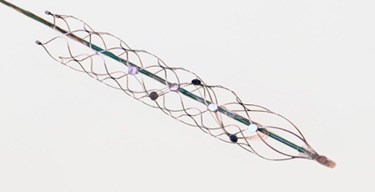DARPA: Minimally Invasive Implant Could Unlock Thought-Controlled Prosthetics

Research partially funded by the Defense Advanced Research Projects Agency (DARPA) has uncovered a minimally invasive method of recording brain activity, which may be able to convert that data into electrical commands. When implanted, the matchstick size “stentrode” can achieve brain machine interface (BMI), necessary for thought-controlled prosthetic devices.
The stentrode builds upon technology used by endovascular surgeons for years to open blocked blood vessels and restore blood flow. While many neuro implants require surgeons to open the skull, the stentrode can be placed via catheter angiography, which threads the device through blood vessels in the neck and into the brain without compromising the skull or blood-brain barrier, according to a DARPA press release. An attached array of electrodes can then record passing neurons.
The device was developed by a team at the Vascular Bionics Laboratory at the University of Melbourne (UM), led by neurologist Thomas Oxley. In a study published by Nature Biotechnology, researchers were able to establish proof-of-concept results after implanting the device into the superficial cortical vein of sheep. The team was able to capture 190 days of high-fidelity recordings of neural activity in the motor cortex — the area of the brain that controls voluntary movement — from the freely roaming sheep.
Terry O’Brien, head of medicine at the Department of Medicine and Neurology at UM, told Reuters, “The big breakthrough is that we now have a minimally invasive brain-computer interface device which is potentially practical for long-term use.”
The stentrode project is part of the Reliable Neural-Interface Technology (RE-NET) program, established by DARPA in 2010 to address the unmet need for high-performance prosthetic devices. RE-NET’s goal is to investigate methods of extracting information from the central nervous system, which can be used to control degree-of-freedom (DOF) machines.
According to RE-NET program manager Doug Weber, technology currently exists that allows scientists to record brain activity through an implanted electrode array, but that technology requires open-brain surgery. Recordings collected with the minimally-invasive stentrode were of equal quality to those collected with more invasive methods.
“By reducing the need for invasive surgery the stentrode may pave the way for more practical implementations of those kinds of life-changing applications of BMIs,” said Weber.
UM researchers remarked that the implant may be used to treat a wide variety of neurological conditions, as well as to control DOF machines. Clive May, professor at the Florey Institute of Neuroscience and Mental Health, told Reuters that the stentrode could be used to predict seizures in epilepsy patients or allow patients to communicate through a computer.
Reuters reports that the research team plans to begin human trials with the device next year, and that thought controlled prosthetic limbs and wheelchairs could be available within a decade.
Last year, Harvard researchers introduced electrode array technology that could be injected into the brain. Also, NIH-funded research has developed a neuro implant one-tenth the size of a human hair.
